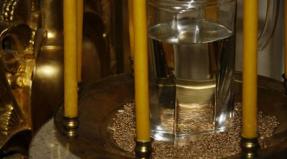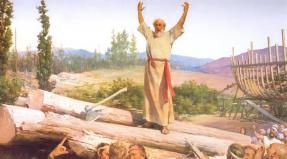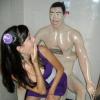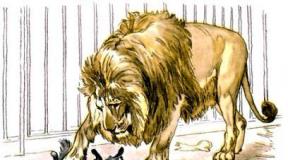How to be baptized in the Old Believer Church. About Old Believers and the Importance of Immersion Baptism
Even a little enlightened person knows that Old Believers are baptized differently than Christians of other denominations. This sign of the cross is called " two-fingered", Because it does not consist of one, not three, not four or five fingers, but only two.
Why are Christians baptized?
The sign of the cross is placed by Christians as a sign that we confess the Lord crucified on the cross. With the sign of the Cross at the beginning of every work, we testify that everything we do takes place for the glory of the Crucified Christ.
Sign of the Cross, i.e. the custom of tracing a cross on the body by placing fingers on the forehead, percy and ramen (shoulders) is an ancient custom that appeared along with Christianity. The custom of Christians to cross themselves in the prayer of St. Basil the Great counts among those who we have received from the apostolic tradition by succession.
How to fold your fingers during the sign of the cross?
For the sign of the cross, we fold the fingers of our right hand like this: "the great with two little ones." This marks, according to the teachings of the Great Catechism, the Holy Trinity: God the Father, God the Son and God the Holy Spirit, not three gods, but the One God in the Trinity, which is divided by names and persons, but the Deity is one. The Father is not born, and the Son is born and not created; The Holy Spirit is neither born nor created, but is original (Great Cat.). Two fingers (forefinger and great middle), joining together, we have extended and slightly inclined - this forms two natures of Christ: the Divine and humanity; with one (index) finger we mean the Divine, with the other (middle), slightly bent, we mean humanity; the inclination of the fingers is interpreted by the holy fathers as an image of the incarnation of the Son of God, Who "Bow down to heaven and come down to our earth for the sake of salvation".
Having folded the fingers of the right hand in this way, we put two fingers on our forehead, i.e. forehead. By this we mean that “ God the Father is the beginning of all the Divine, from Him first the Son was born and in the last times bow down to heaven, descended to earth and became a man". When we put our fingers on our stomach, we signify by this that in the womb of the Most Holy Theotokos by the overshadowing of the Holy Spirit there was the seedless conception of the Son of God; I was born from her and on earth from a man in gain, suffered in the flesh for our sins, was buried and on the third day he rose again and raised from hell the righteous souls who dwelt there. When we put our fingers on our right shoulder, it is interpreted as follows: first, that Christ ascended into heaven and gray at the right hand of God the Father; second, that on the day of judgment the Lord will set the righteous at His right hand (on the right hand), and sinners - on the left hand. The standing of sinners on the left hand also means the position of the hand when making the sign of the cross on the left shoulder (Big Catech., Ch. 2, leaves. 5, 6).

Where did the two-finger come from?
The custom of folding our fingers in this manner was adopted by us from the Greeks, and they kept it invariably from the time of the apostles. Scientists, prof. Kapterev and Golubinsky, have collected a number of testimonies that in the XI-XII centuries the Church knew only two-finger sign. We also find two fingers on all ancient icon images (mosaics and frescoes of the XI-XIV centuries).

Information about two-fingered fingers is also found in Old Russian literature, including the works of the Monk Maxim the Greek and the famous book "Domostroy".
Why not a three-finger?
Usually, believers of other confessions, for example, new believers, ask why the Old Believers do not cross themselves with three fingers, like members of other Eastern churches.
 |  |
On the left is a three-fingered sign, this sign of the cross is accepted by the New Believer tradition. On the right - two-fingered, with this sign of the cross, the Old Believers overshadow themselves
The answer to this is the following:
- Two-fingered was commanded to us by the apostles and fathers of the ancient Church, to which there is a lot of historical evidence. The three-finger is a newly invented rite, the use of which has no historical basis;
- The keeping of the two-finger is protected by the church oath, which is contained in the ancient rite of acceptance from the heretics Jacobite and the decrees of the Stoglava Council of 1551: "If anyone does not bless two fingers as well as Christ, or does not imagine the sign of the cross, be damned";
- Two-fingered reflects the true dogma of the Christian Creed - the crucifixion and resurrection of Christ, as well as two natures in Christ - the human and the Divine. Other types of the sign of the cross do not have such a dogmatic content, and the three-finger distorts this content, showing that the Trinity was crucified on the cross. And although the new believers do not contain the doctrine of the crucifixion of the Trinity, St. the fathers categorically forbade the use of signs and symbols that have a heretical and non-Orthodox meaning.
Thus, in polemicizing with Catholics, the holy fathers also pointed out that the mere change of the vision, the use of customs similar to the heretical ones, is in itself a heresy. Bp. Nikola Mefonsky wrote, in particular, about unleavened bread: “ The user of unleavened bread is already suspected of being in contact with these heresies out of some resemblance.". The truth of the two-fingered dogma is recognized today, albeit not publicly, by various New Rite hierarchs and theologians. So oh. Andrey Kuraev, in his book Why Orthodox Christians Are Like This, points out: I consider the two-finger to be a more accurate dogmatic symbol than the three-finger. After all, not the Trinity was crucified, but “one of the Holy Trinity, the Son of God» ».
Many people ask the question: "Who are the Old Believers, and how do they differ from the Orthodox believers?" People interpret Old Belief in different ways, equating it either with religion or with a variety of sects.
Let's try to understand this extremely interesting topic.
Old Believers - who are they
Old Belief emerged in the 17th century as a protest against changes in old church customs and traditions. A schism began after the reforms of Patriarch Nikon, who introduced innovations in church books and church order. All who did not accept the changes and cared for the preservation of old traditions were anathematized and persecuted.

A large community of Old Believers soon split into separate branches, which did not recognize the sacraments and traditions of the Orthodox Church and often had different views on the faith.
Avoiding persecution, the Old Believers fled to unsociable places, settling in the North of Russia, the Volga region, Siberia, settled in Turkey, Romania, Poland, China, reached Bolivia and even Australia.
Customs and traditions of the Old Believers
The current way of life of Old Believers practically does not differ from that which their grandfathers and great-grandfathers used several centuries ago. In such families, history and traditions are honored, passed on from generation to generation. Children are taught to honor their parents, brought up in severity and obedience, so that in the future they will become a reliable support.

From an early age, sons and daughters are taught to work, which the Old Believers hold in high esteem. They have to work a lot: Old Believers try not to buy groceries in the store, so they grow vegetables and fruits in their gardens, keep cattle in perfect cleanliness, do a lot for the house with their own hands.
They do not like to tell strangers about their lives, and even have separate dishes for those who come to the community from the outside.

To clean the house, use only clean water from a consecrated well or spring. The bathhouse is considered an unclean place, so the cross must be removed before the procedure, and when they enter the house after the steam room, they must wash themselves with clean water.
The Old Believers pay great attention to the sacrament of baptism. They try to baptize the baby within a few days after his birth. The name is chosen strictly according to the calendar, and for a boy - within eight days after birth, and for a girl - in the range of eight days before and after birth.
All the attributes used for baptism are kept in running water for some time so that they become clean. Parents are not allowed to christening. If mom or dad witnesses the ceremony, then this is a bad sign that threatens divorce.

As for wedding traditions, relatives up to the eighth generation and relatives “on the cross” have no right to go down the aisle. No wedding is played on Tuesday and Thursday. After marriage, a woman constantly wears a shashmura headdress; it is considered a great sin to appear in public without it.
Old Believers do not wear mourning. According to custom, the body of the deceased is washed not by relatives, but by people chosen by the community: a man is washed by a man, a woman is washed by a woman. The body is placed in a wooden coffin with shavings at the bottom. Instead of a cover - a sheet. At the commemoration, the deceased is not commemorated with alcohol, and his things are distributed to those in need as alms.
Are there Old Believers in Russia today?
In Russia today there are hundreds of settlements in which Russian Old Believers live.

Despite different trends and branches, they all continue the way of life and way of life of their ancestors, carefully keep traditions, bring up children in the spirit of morality and ambition.
What is the cross of the Old Believers
In church rituals and divine services, Old Believers use an eight-pointed cross, on which there is no image of the Crucifixion. In addition to the horizontal bar, the symbol has two more.

The upper one depicts a tablet on the cross where Jesus Christ was crucified, the lower one implies a kind of "scale" that measures human sins.
How Old Believers are baptized
In Orthodoxy, it is customary to make the sign of the cross with three fingers - three fingers, symbolizing the unity of the Holy Trinity.

Old Believers cross themselves with two fingers, as was customary in Russia, saying twice "Alleluia" and adding "Glory to Thee, God."
For divine services they put on special clothes: men put on a shirt or blouse, women - a sundress and a scarf. During the service, the Old Believers cross their arms over their chest as a sign of humility before the Almighty and bow down to the ground.
Where are the settlements of the Old Believers
In addition to those who remained in Russia after Nikon's reforms, the Old Believers who have lived in exile outside its borders for a long time continue to return to the country. They, as before, honor their traditions, raise livestock, cultivate the land, and raise children.

Many took advantage of the resettlement program to the Far East, where there is a lot of fertile land and there is an opportunity to build a strong economy. Several years ago, Old Believers from South America returned to Primorye thanks to the same voluntary resettlement program.
In Siberia and the Urals, there are villages where Old Believer communities are firmly established. There are many places on the map of Russia where the Old Believers flourish.
Why the Old Believers were called bespopovtsy
The split of the Old Believers formed two separate branches - priesthood and bezpopovshchina. Unlike the Old Believers-priests, who, after the schism, recognized the church hierarchy and all the sacraments, the Old Believers-priests began to deny the priesthood in all its manifestations and recognized only two sacraments - Baptism and Confession.
There are Old Believers who also do not deny the sacraments of Marriage. According to bespopovtsy, the Antichrist has reigned in the world, and all modern clergy is heresy, from which there is no sense.
What is the Bible of the Old Believers
The Old Believers believe that the Bible and the Old Testament in their modern interpretation are distorted and do not carry the original information that should carry the truth.

In their prayers, they use the Bible, which was used before Nikon's reform. Prayer books of those times have survived to this day. They are carefully studied and used in worship.
How Old Believers differ from Orthodox Christians
The main difference is this:
- Orthodox believers recognize church rites and sacraments of the Orthodox Church, believe in its teachings. The Old Believers consider the old pre-reform texts of the Holy Books to be true, not recognizing the changes made.
- Old Believers wear eight-pointed crosses with the inscription "King of Glory", there is no image of the Crucifixion on them, they cross with two fingers, and bow down to earth. In Orthodoxy, three fingers are accepted, crosses have four and six ends, mostly they bow in the waist.
- The Orthodox rosary is 33 beads, the Old Believers use the so-called ladders, consisting of 109 knots.
- Old Believers baptize people three times, completely immersing them in water. In Orthodoxy, a person is doused with water and partially immersed.
- In Orthodoxy, the name "Jesus" is written with a double vowel "and", Old Believers are faithful to traditions and write it as "Jesus".
- There are more than ten different interpretations in the Symbol of Faith of Orthodox and Old Believers.
- Old Believers prefer copper and pewter icons to wooden ones.
Conclusion
A tree can be judged by its fruit. The purpose of the Church is to lead her spiritual children to salvation, and it is possible to assess her fruits, the result of her labors, according to the gifts that her children acquired.
And the fruits of the Orthodox Church are the host of Holy martyrs, saints, priests, prayer books and other wondrous Benevolers of God. The names of our Saints are known not only to Orthodox, but also to Old Believers, and even not to church people.
Today, Russianorthodox church celebrates Epiphany. I dedicate this glorious date.
Excerpt from the series of articles "Orthodoxy is not Christianity"
; ; ; ;
In the early 2000s, I had to travel a lot to different places, including remote, sparsely populated and abandoned villages. In one such village, located in the upper reaches of the Yuryuzan River, we met a local resident who lived there with his wife. Apart from them, at that time practically no one lived in that village. The townspeople came either to the dacha or local officials to hunt. At that moment, we were looking for a place for a settlement, which ultimately was formed there, and now more than a dozen families live permanently and a dozen more are being built.
In general, word for word, and it turned out that he was an Old Believer, and the whole village was Old Believers. Apparently he liked us, because he once told us: "If you settle here with us, then I will orchest you in the river as it should."
- Grandfather, how should it be?
- How, how, in the river, of course!
In general, he told us how their children were baptized before.
A week after birth, at dawn, everyone went to the river (family and relatives, for a small village, almost all are relatives of each other). In winter they cut a hole in advance. Near the river, when the Sun rose, the father took the baby from the mother, and went with him into the river (or went down into the ice-hole) so that the water was just above the belt. I dipped the baby completely, head first, into the water. Their village is located so that the sun rises behind the river. That is, when entering the river, the father found himself facing the Sun. When he took the baby out of the water, then with a bow he presented him first to the Sun, and then to "all four winds." That is, four more obeisances were made in the four cardinal directions with a clockwise rotation, "along the salt line" (that is, according to the Sun). After that, the father and the child came out of the river, but they did not wipe the child, but waited until he dries up himself, and only then the baby was handed over to the mother and swaddled.
We asked him, but what if the frost is strong in winter? And he says that he doesn't remember when it happened. First, children were mainly born in spring, May-June. He says they deliberately tried to tell fortunes. Therefore, in winter, children were born to them very rarely. But if they were born, then, he says, the grandmothers somehow did that, that on the day when the baby had to go to baptize, there was never a severe frost.
We asked him, is this baptism? And he says: "Well, after all, bows on four sides, here is the cross for you!"
There were old icons in his house in the corner, but they do not go to a modern church and do not like modern priests. They say: "They are dressed up, they are not real, they do not know how to do anything, just wave a censer."
Now compare this with what the modern ROC is doing. Moreover, there is much more sense in the action described by the Old Believer than in what the Russian Orthodox Church calls “baptism”. This is a ceremony of presenting a newborn to the God-Sun and the Spirits of natural forces, water and wind. A pagan rite? Undoubtedly! Is there sun worship? Of course!
"Save me, God!". Thank you for visiting our site, before you start studying the information, please subscribe to our Orthodox community on Instagram, Lord, Save and Save † - https://www.instagram.com/spasi.gospodi/. The community has over 60,000 subscribers.
There are many of us, like-minded people, and we are growing rapidly, posting prayers, sayings of saints, prayer requests, timely posting useful information about holidays and Orthodox events ... Subscribe. Guardian Angel to you!
Patriarch Nikon carried out a series of reforms in the 17th century, caused by the need to bring the Church to a single image of liturgical practice. Some of the clergy with worldly people did not accept these changes, proclaiming that they were deviating from the old customs, and called Nikon's innovations "corruption of belief." They announced that they wish to preserve the old traditions and statutes in the divine services. It should be noted that it will be rather difficult for an uninitiated person to distinguish an Old Believer from an Orthodox believer, because the differences between the new and the old faith are not so great. In this article, you can learn about what the Old Believers are, how the Old Believers differ from the Orthodox, and find out the answers to the most interesting questions of Orthodox people.
Orthodox believers are those Christians who recognize the teachings advanced by the Christian Church.
Old Believers are believers who wanted to leave the Christian Church because of their disagreement with the reforms carried out by Patriarch Nikon.
Experts on church history have established about a dozen distinctive features of Old Believers from ordinary Christian believers in matters of worship and other ritual ceremonies, reading and interpretation of Scripture, everyday matters, as well as appearance.
It should be noted that the Old Believers are heterogeneous, that is, there are various trends among them, which also make some differences, but already among the adherents of the old belief themselves.
Let's take a closer look at how Old Believers differ from Orthodox Christians:
- It does, but the Old Believers still enjoy using the form of the Christian symbol. It, as a rule, has eight ends, and two more small crossbars are added to our usual cross, oblique from below and straight from above. However, according to the studies carried out, some of the Old Believers' beliefs also recognize some other forms of the Lord's cross.
- Bows. Unlike ordinary Christians, Old Believers recognize only prostrations to the ground, while the latter use waist bows.
- How to be baptized. Nikon during the period of his church reform put forward a prohibition according to which one cannot be baptized with two fingers according to the old custom. An order was given to all to carry out the sign of three fingers. That is, to be baptized in a new way - with three fingers laid in a pinch. The Old Believers, in turn, did not accept this position, seeing in this a fig (i.e. a fig) and completely refused to follow the newly introduced decree. Old Believers to this day carry out the sign of the cross with two fingers. As described earlier, the Old Believers always have an eight-pointed cross, which is located inside a four-pointed one. The main difference is that the image of the crucified Savior is never applied to such a cross.
- Differences in the spelling of the name of the Almighty. In some prayers, there are discrepancies, which, according to estimates, there are about 62 one scientist-historian.
- Old Believers during the divine service keep their crossed arms on their chest, and Christians hold their hands at the seams.
- Almost complete rejection of alcoholic beverages and tobacco products. The Old Russian Church of Orthodox Old Believers, only in some Old Believer tales, allows the acceptance of three glasses of alcohol on the great holidays, but no more than that.
- Appearance. In the Old Believers' temples of God, in comparison with Christian ones, there are no women and girls in hats, scarves or kerchiefs that are tied at the back with a knot. Old Believer women should be strictly in a scarf, stabbed under the chin with a pin. Nothing colorful and bright is allowed in clothes. Men, on the other hand, should wear old Russian shirts outside and be sure to supplement it with a belt that will divide several parts of the body into the upper, that is, the spiritual and the lower, dirty. An Old Believer man in everyday life is forbidden to wear ties, considering them as a Judas' stranglehold, and also to shave off his beard.
Frequently asked Questions
Some Christians, and also Old Believers, may be interested in a lot of questions that are encountered quite often in everyday life. Let's consider some of them.
Is it possible for Old Believers to go to the Orthodox Church and is it possible to be baptized with two fingers
Old believers are allowed to visit God's temple, but if the adherents of the old faith express a desire to be Orthodox, then first they need to accept the Confirmation, that is, the Sacrament, which will unite a person with the Christian new faith.
To be baptized with two or three fingers today does not have any special meaning, since these two rites were recognized as equal. But nevertheless, it is worth noting that if you visit God's temple and are baptized there with two fingers, when everyone else is baptized only with the crown of the fingers, it will look ridiculous and even ugly;
Can an old believer be a godfather for an Orthodox
It is not worth completely rejecting the possibility of the presence of a non-Orthodox Christian as a godfather during the performance of the Orthodox rite of Baptism, but this is possible only if the Old Believer is only one of the godfathers, and the second godparent will necessarily be a Christian of the new belief.
There is also one more condition under which the Old Believer is allowed to take part in the ceremony, if he does not make any attempts to educate the child in non-Orthodox traditions.
The Lord is always with you!
Post navigation
22 thoughts on “ How do Old Believers differ from Orthodox”
Have old believers-bezpopovtsevThe sacrament of Baptism is performed both in natural reservoirs and in a font. If baptism takes place in the font, then the water after each baptized person must change - it is unacceptable to immerse two baptized people in the same water, since the sins of the pre-baptized person seem to remain in this font. The ordinances of the sacrament of baptism are strictly observed, however, due to historical circumstances, only those sections of consumers that were intended for laymen in case of the absence of a priest are realized in practical life:
Our Small Consumer, even in non-priestly times, was drawn up quickly, but not without the Cathedral reason for the Big Consumer, and only the priest's prayers were shortened, and additional questions were placed in confession. (Answer of the spiritual mentor Fr. spiritual mentor Father Alexander Khrychev on the rite of the Sacrament of Baptism)
Bezpopovstvo never rejected as an idea a single church sacrament or rite, did not question the status of the priesthood as the bearer of God's grace. Due to the fact that, according to the teachings of the Old Believers-Bezpopovtsy, after the schism of the 17th century, the apostolic succession of the Orthodox clergy was cut short, the grace of the priesthood was interrupted, the church hierarchy ceased, problem reception converts turned out to be one of the primary and very difficult. Old Believer bezpopov thinkers in the 18th century explained in their writings that in the current historical situation it is impossible, due to the absence of the ancient Orthodox church hierarchy, to preserve "the invariable completeness of all external forms of the Church's existence," and therefore partial deviations are inevitable, as evidenced by examples from the Old and New Covenant, from the writings of the holy fathers and the history of the Church:
Bunnecessarily, those who dare not in behavior, like criminals of the law, are condemned. Out of need, however, the daring one is not just condemned, but they are worthy of praise and honor, and are justified from all teachers. But there is a lot of flight in this reasoning, as in such there is like daring, in which the most extreme need commands, but not when this is a supply to need, and unnecessary times, and to the need of a secret need for action we begin to produce.
Orthodox canons allow the layman to baptize and re-baptize, that is, to accept “ from heresies coming"The first rank. It is customary for Old Believers-bezpopovtsy (except) to perform baptism it is necessary for all who wish to pass from official Orthodoxy to the Old Believers. There is also the practice of re-baptizing when transferring to the community of Old Believers from other sects and consents. , justifying re-baptism, they wrote that in general every heretic is subject to re-baptism, and if the church had not baptized some heretics before, then this should be understood not as a law, but as “ condescension»In the hope of their early appeal. Admission to the second and third ranks, in the absence of the priesthood, is impossible.
Regarding the reception of the priests who accepted the "Nikonian" baptism, initially there was no consensus among the Bezpop ideologists. It is known that the dispute about the re-baptism of priests in the 1710s took place among starodub Pomors... When those who arrived in Starodubye from Kerzhensky forests began to re-baptize the priests, the local pomeranian mentor Spiridon Ivanov... His message to Kerzhenets has survived, justifying the inadmissibility of re-baptizing priests. However, soon all the bezpopovtsy (again, except for the Spassovtsy) made it a rule to re-baptize the priests who were passing over to them.
In the first half of the 18th century, the principles of ritual reception, based on Orthodox rules, pertaining not to heretics, but to sinners, were affirmed in the agreements. The reception of the Fedoseevites by the Pomors and vice versa was carried out through a special prayer rule - penitent began. Polish Fedoseevsky Cathedral in 1751, he somewhat toughened the requirements for the Pomors who were passing into Fedoseevsky consent, establishing that, in addition to the beginning, they must put 300 bows to the ground.
The first mentors in different ways carried out the reception of neophytes, passing from the Pomor and Fedoseyev accords. Himself monk Philip and his student monk Matthew continued to use the principles of repentance to receive new converts. Philip's disciple, monk Terenty, spoke in favor of a stricter rule, stating that those who apply to bezpopovtsy should endure a six-week fast.
Baptism in the Old Orthodox Pomeranian Church
Before a person accepts Holy Baptism and becomes a true Christian, he becomes “catechumed”, not yet baptized, but already instructed in the basics of faith. The need for announcement is indicated in 46 rule Laodicean and 78 rule Sixth Ecumenical Councils... The announcement began in the early days of the Church. So, after the sermon of the apostle Petra in Jerosalim, about three thousand people converted to Christianity for the feast (Acts 2: 14-41). He later instructed the Roman centurion in the faith Cornelia with his family, and then allowed them to be baptized (Acts 10, 24-48). The apostles did the same Pavel (Acts 16, 13-15), Philip (Acts 8: 35-38) and others.
The firmness of the decision to accept the new faith was tested. During the persecution of Christians, there were cases of their falling away from the Church, therefore, during the period of training, the Church was sure to keep an eye on the catechumens - were there any traitors to Christianity among them who falsely accepted Holy Baptism. If such were found, they were immediately expelled from the assembly of the catechumens. The announcement period was long - from three months to three years, and this time was divided into several stages, and the catechumens were divided into different classes. We have come down to the public talks of the saints, Cyril of Jerosalim, Gregory of Nyssa, Ambrose of Mediolan, Theodore of Mopsuestia, Augustine the Blessed.

The catechumens had to learn to pray outside the walls of the Temple, about which he writes Cyril of Jerosalim: « Pray more often that God will honor you with the heavenly and immortal Mysteries". In addition, the catechumens had to lead a Christian life: fast, keep the Commandments, fight against sin, repent of sins before God and people, and correct their spiritual vices.
Those who are going to be baptized need to prepare for this by frequent prayers, fasting, kneeling, vigilance and confession of all their past sins ..., - writes to the catechumens Tertullian.
Jesus Christ demanded from those who undertake to baptize someone, be sure to teach him (Matthew 28, 19), and the Pomor Church responsibly approaches the acceptance of new members into her fold, reverently relates to the very Sacrament of Baptism. Those who come to the Pomeranian Church for the first time and want to be baptized are interviewed with a spiritual mentor, tell about themselves and the reasons for their intention. The mentor preaches to them a sermon about the Christian faith, about what the Christian life is, how Christianity differs from other religions, how a Christian should live.
After this, initiation into the catechumens takes place, when the catechuchman lays down a conciliatory beginning. The moment of announcement in the Pomeranian Church is considered the position of the incoming beginning in the cell of the mentor at the church. The mentor explains and shows how to correctly place the sign of the cross and bows. An approximate period of baptism is assigned, a commandment is given, future recipients are determined, and a baptismal reminder is presented. Requirements for receivers are higher than for baptized adults. Recipients should belong to the Church not only formally (that is, be baptized), but also in fact (regularly confess, attend cathedral services), be able to teach godchildren of the Christian life not only by word, but also by personal example.
A little later, a confessional conversation takes place, before baptism the catechuchman must remember all his grave sins. It turns out if there are any obstacles, the main of which are drunkenness, tobacco smoking, drug addiction and many others.
In 2008, the congress of spiritual mentors of the Old Orthodox Pomeranian Church, having considered the canonical foundations and the practical procedure for performing the sacraments, services and corrections in the communities of the DOC, set the time for preparation for Holy Baptism (announcement) in accordance with Christian custom - 40 days. In this case, the specific period can be reduced or increased and is chosen by the spiritual mentor depending on the readiness of the baptized person and other circumstances. The order of preparation for baptism (fasting, prayer, fulfilling the commandment) is determined by the spiritual mentor.

Baptism in the Old Orthodox Pomeranian Church can be accepted regardless of age, gender, nationality, state of health (except for loss of mind, consciousness), previous religion. Children under the age of 12 are usually baptized if either parent belongs to the Old Belief. The baptism of adults is performed only after a preliminary conversation with a spiritual mentor (announcement) and a preparatory period of varying length. The mentor must necessarily teach the person who wants to be baptized the ancient Orthodox faith, explain the meaning of the sacraments and their necessity for the salvation of the soul.
With the Sacrament of Baptism, a new life of a person begins, which is dedicated to serving God and neighbors, life according to the laws of Christ. Baptism is the spiritual birth of a new person, which occurs according to the faith of the baptized person. He who receives baptism without faith is condemned by the Lord. The Lord God Himself said:
Whoever has faith and is baptized will be saved, and whoever does not have faith will be condemned (Gospel of Mark, Conch. 16).
The Holy Spirit is given to the firm believers immediately after Baptism, but to the unfaithful and wicked, it is not given after baptism. (Rev. Mark the Ascetic)
A person who accepts baptism only formally or for the acquisition of any benefit comes to this sacrament in vain. He is washed only outwardly, that is, the body sank into the water and came out of the water, but the soul did not bury with Christ and did not rise with Him, and the water for such remains water.
A man baptizes him, but the Holy Spirit will not baptize him, writes St. Cyril of Jerosalim.
The newly baptized one who has accepted the holy faith of his own free will and has decided to be spiritually reborn and no longer sin, must in fact fulfill his promises to the Lord God. Otherwise, these words-promises will not only not contribute to salvation, but also go into condemnation:
It is better for you not to promise than to promise and not to fulfill (Eccl. 5.4).
Babies are baptized according to the faith of their parents. When a baby is baptized, the recipients promise God that their godson will live a Christian life, become a true soldier of Christ.
On the rite of baptism in the Pomeranian Church
In addition to the baptized person and the mentor, two godparents participate in the rite of baptism (if need be, one is possible) - male and female from among the Old Believers over 12 years old. The spouses or the bride and groom cannot be godparents at the same time. If you have any health problems, you should notify your spiritual mentor in advance. Participants in baptism must be dressed in a Christian way - with covered arms and legs, with a cross and a belt, women - in headscarves and dresses (skirts), without makeup, not in a state of critical days. Food on the day of baptism is not eaten in the morning (except for small children). Godparents and baptized (adult) must know the Creed.

For baptism you must:
Babies:pectoral cross on gaitan, belt, baptismal set of white (light) clothes, diaper, undershirt, cap, small towel.
Adults: pectoral cross on gaitan, belt, sheet or large towel, white baptismal shirt with sleeves and without images, of sufficient length; small towel, for women - a light shawl. The white color of the clothes in which the baptized are clothed means the future mental and physical purity, which they promise to keep from that moment on.
You should also purchase candles that will stand in front of the faces of holy icons, and 4 candles that are attached to the font. Burning candles are a symbol of the soul of the baptized person enlightened by grace. There is no baptism fee:
Priyaste to tuna, give tuna (Gospel of Matthew, sc. 34)
The rite of baptism is common for all who come to baptism, but baptism itself is performed separately in different fonts, in complete exposure, three times full immersion in water. Only baptismal participants are admitted to the baptismal. When small children are baptized, the presence of relatives is possible. Photo and video filming during the rite of baptism prohibited... Those who were baptized before the 8th day are not completely allowed to wash their bodies and change the baptismal shirt, and those who are married must be in abstinence. All special cases of baptism (outside the church, at other times, etc.) are performed by agreement with the spiritual mentor.



















